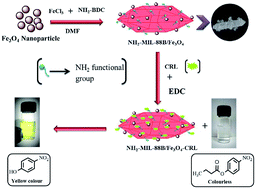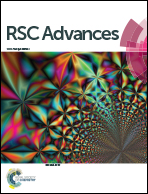Fabrication of a magnetic nanoparticle embedded NH2-MIL-88B MOF hybrid for highly efficient covalent immobilization of lipase
Abstract
Metal–organic frameworks (MOFs), a class of porous hybrid materials composed of metal ions and organic ligands, have been studied for a variety of applications. In this work, for the first time, magnetic MOFs are developed for lipase immobilization. A general one-step in situ hydrothermal route is developed for the construction of MOFs encapsulating superparamagnetic Fe3O4 nanoparticles. The integration of Fe3O4 nanoparticles into the MOFs exhibits many interesting inherent properties including a porous nature, easy functionalization as well as strong superparamagnetism. Here Candida rugosa lipase (CRL) is covalently attached to amino-rich magnetic MOFs. The resulting magnetic MOFs are characterized by means of field emission scanning electron microscopy (FESEM), Fourier transform infrared spectroscopy (FT-IR), thermogravimetric analysis (TGA) and vibrating sample magnetometer (VSM) measurements. Then the enzymatic activities of the immobilized CRL are compared with free CRL. The immobilized CRL presented a wider pH tolerance and excellent thermal stability than free CRL. The Michaelis–Menten kinetic constant (Km) and maximum reaction velocity (Vmax) for both free and immobilized lipase are investigated. The loading amount of CRL on the magnetic MOFs was 280 mg per g of support and the immobilized CRL was efficiently recycled for up to nine cycles.


 Please wait while we load your content...
Please wait while we load your content...